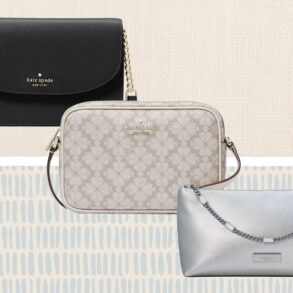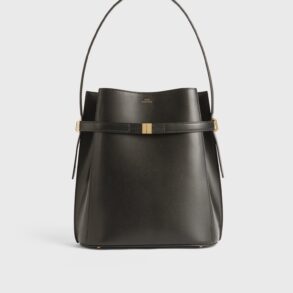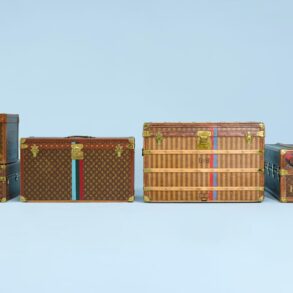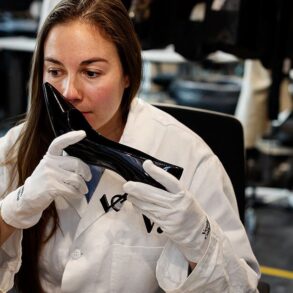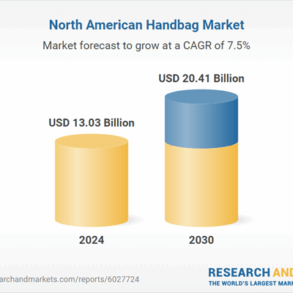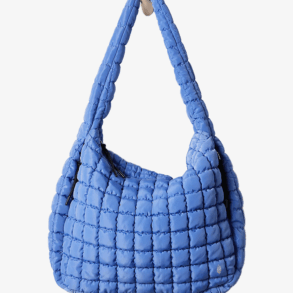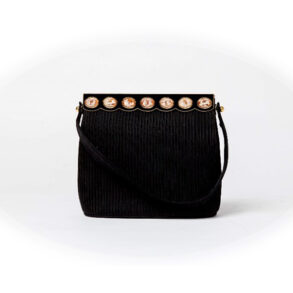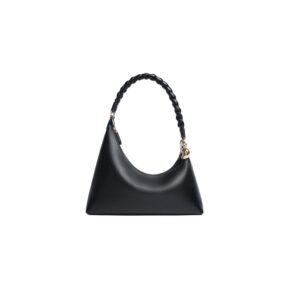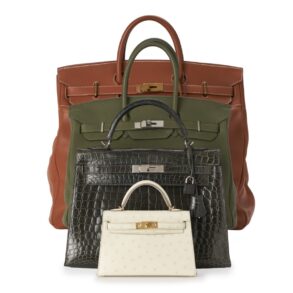Jun 2, 2025
IndexBox has just published a new report: EU – Luggage And Handbags – Market Analysis, Forecast, Size, Trends and Insights.
The European Union market for luggage and handbags is poised for steady growth in the coming years, with a forecasted CAGR of +1.3% in volume and +3.4% in value from 2024 to 2035. This growth is fueled by rising consumer demand, indicating a promising future for this industry.
Market Forecast
Driven by increasing demand for luggage and handbags in the European Union, the market is expected to continue an upward consumption trend over the next decade. Market performance is forecast to retain its current trend pattern, expanding with an anticipated CAGR of +1.3% for the period from 2024 to 2035, which is projected to bring the market volume to 807M units by the end of 2035.
In value terms, the market is forecast to increase with an anticipated CAGR of +3.4% for the period from 2024 to 2035, which is projected to bring the market value to $12.2B (in nominal wholesale prices) by the end of 2035.

Consumption
European Union’s Consumption of Luggage And Handbags
In 2024, approx. 699M units of luggage and handbags were consumed in the European Union; with an increase of 26% against 2023. The total consumption volume increased at an average annual rate of +1.0% over the period from 2013 to 2024; the trend pattern remained relatively stable, with somewhat noticeable fluctuations throughout the analyzed period. Over the period under review, consumption attained the maximum volume in 2024 and is expected to retain growth in years to come.
The value of the luggage market in the European Union surged to $8.4B in 2024, picking up by 19% against the previous year. This figure reflects the total revenues of producers and importers (excluding logistics costs, retail marketing costs, and retailers’ margins, which will be included in the final consumer price). The total consumption indicated tangible growth from 2013 to 2024: its value increased at an average annual rate of +4.2% over the last eleven-year period. The trend pattern, however, indicated some noticeable fluctuations being recorded throughout the analyzed period. Based on 2024 figures, consumption increased by +53.3% against 2020 indices. Over the period under review, the market reached the maximum level in 2024 and is expected to retain growth in the near future.
Consumption By Country
The countries with the highest volumes of consumption in 2024 were the Netherlands (132M units), Germany (121M units) and Italy (98M units), together comprising 50% of total consumption.
From 2013 to 2024, the biggest increases were recorded for the Netherlands (with a CAGR of +16.4%), while consumption for the other leaders experienced more modest paces of growth.
In value terms, Germany ($3.4B) led the market, alone. The second position in the ranking was held by the Netherlands ($1.1B). It was followed by Italy.
From 2013 to 2024, the average annual rate of growth in terms of value in Germany amounted to +4.2%. The remaining consuming countries recorded the following average annual rates of market growth: the Netherlands (+18.7% per year) and Italy (-0.3% per year).
In 2024, the highest levels of luggage per capita consumption was registered in the Netherlands (7.5 units per person), followed by Portugal (2.4 units per person), Greece (2.3 units per person) and Italy (1.7 units per person), while the world average per capita consumption of luggage was estimated at 1.6 units per person.
In the Netherlands, luggage per capita consumption expanded at an average annual rate of +15.9% over the period from 2013-2024. In the other countries, the average annual rates were as follows: Portugal (+4.6% per year) and Greece (+5.4% per year).
Production
European Union’s Production of Luggage And Handbags
In 2024, production of luggage and handbags was finally on the rise to reach 171M units after two years of decline. Overall, production, however, recorded a relatively flat trend pattern. The pace of growth appeared the most rapid in 2016 with an increase of 83% against the previous year. As a result, production attained the peak volume of 376M units. From 2017 to 2024, production growth remained at a lower figure.
In value terms, luggage production soared to $17.3B in 2024 estimated in export price. In general, production enjoyed a resilient increase. Over the period under review, production hit record highs at $18.8B in 2021; however, from 2022 to 2024, production stood at a somewhat lower figure.
Production By Country
The country with the largest volume of luggage production was Germany (68M units), comprising approx. 40% of total volume. Moreover, luggage production in Germany exceeded the figures recorded by the second-largest producer, Italy (34M units), twofold. France (20M units) ranked third in terms of total production with a 12% share.
From 2013 to 2024, the average annual rate of growth in terms of volume in Germany totaled -2.0%. The remaining producing countries recorded the following average annual rates of production growth: Italy (+0.9% per year) and France (+12.5% per year).
Imports
European Union’s Imports of Luggage And Handbags
In 2024, approx. 845M units of luggage and handbags were imported in the European Union; remaining stable against the previous year’s figure. The total import volume increased at an average annual rate of +1.3% over the period from 2013 to 2024; however, the trend pattern indicated some noticeable fluctuations being recorded throughout the analyzed period. The growth pace was the most rapid in 2022 with an increase of 37%. As a result, imports attained the peak of 859M units. From 2023 to 2024, the growth of imports failed to regain momentum.
In value terms, luggage imports contracted to $12.6B in 2024. Total imports indicated notable growth from 2013 to 2024: its value increased at an average annual rate of +3.8% over the last eleven-year period. The trend pattern, however, indicated some noticeable fluctuations being recorded throughout the analyzed period. Based on 2024 figures, imports increased by +39.1% against 2020 indices. The most prominent rate of growth was recorded in 2022 when imports increased by 20%. Over the period under review, imports attained the peak figure at $13.9B in 2023, and then contracted in the following year.
Imports By Country
In 2024, the Netherlands (179M units), Italy (142M units), Spain (108M units), France (99M units) and Germany (78M units) was the major importer of luggage and handbags in the European Union, generating 72% of total import. It was distantly followed by Poland (43M units), achieving a 5.1% share of total imports. Portugal (36M units), Belgium (30M units), Greece (28M units) and Denmark (13M units) followed a long way behind the leaders.
From 2013 to 2024, the biggest increases were recorded for the Netherlands (with a CAGR of +12.2%), while purchases for the other leaders experienced more modest paces of growth.
In value terms, the largest luggage importing markets in the European Union were France ($2.5B), Italy ($2.2B) and the Netherlands ($1.7B), together accounting for 51% of total imports.
Among the main importing countries, the Netherlands, with a CAGR of +11.3%, recorded the highest growth rate of the value of imports, over the period under review, while purchases for the other leaders experienced more modest paces of growth.
Imports By Type
Handbags with outer surface of plastic sheeting or of textile materials was the main imported product with an import of around 569M units, which reached 67% of total imports. Cases and containers; trunks, suit-cases, vanity-cases, executive-cases, brief-cases, school satchels and similar containers, with outer surface of plastics or of textile materials (140M units) took the second position in the ranking, distantly followed by travel sets; for personal toilet, sewing, shoe or clothes cleaning (45M units) and handbags with outer surface of leather, composition leather, or patent leather (40M units). All these products together took near 27% share of total imports. The following types – handbags with outer surface of vulcanised fibre or of paperboard (31M units) and cases and containers; trunks, suit-cases, vanity-cases, executive-cases, brief-cases, school satchels and similar containers, with outer surface of vulcanised fibre or of paperboard (15M units) – together made up 5.4% of total imports.
From 2013 to 2024, average annual rates of growth with regard to handbags with outer surface of plastic sheeting or of textile materials imports of stood at +2.7%. At the same time, cases and containers; trunks, suit-cases, vanity-cases, executive-cases, brief-cases, school satchels and similar containers, with outer surface of vulcanised fibre or of paperboard (+13.4%) and handbags with outer surface of vulcanised fibre or of paperboard (+1.4%) displayed positive paces of growth. Moreover, cases and containers; trunks, suit-cases, vanity-cases, executive-cases, brief-cases, school satchels and similar containers, with outer surface of vulcanised fibre or of paperboard emerged as the fastest-growing type imported in the European Union, with a CAGR of +13.4% from 2013-2024. Handbags with outer surface of leather, composition leather, or patent leather experienced a relatively flat trend pattern. By contrast, cases and containers; trunks, suit-cases, vanity-cases, executive-cases, brief-cases, school satchels and similar containers, with outer surface of plastics or of textile materials (-1.4%) and travel sets; for personal toilet, sewing, shoe or clothes cleaning (-4.4%) illustrated a downward trend over the same period. While the share of handbags with outer surface of plastic sheeting or of textile materials (+9.6 p.p.) increased significantly in terms of the total imports from 2013-2024, the share of travel sets; for personal toilet, sewing, shoe or clothes cleaning (-4.7 p.p.) and cases and containers; trunks, suit-cases, vanity-cases, executive-cases, brief-cases, school satchels and similar containers, with outer surface of plastics or of textile materials (-5.7 p.p.) displayed negative dynamics. The shares of the other products remained relatively stable throughout the analyzed period.
In value terms, handbags with outer surface of plastic sheeting or of textile materials ($4.8B), handbags with outer surface of leather, composition leather, or patent leather ($4.3B) and cases and containers; trunks, suit-cases, vanity-cases, executive-cases, brief-cases, school satchels and similar containers, with outer surface of plastics or of textile materials ($2.6B) constituted the products with the highest levels of imports in 2024, with a combined 94% share of total imports.
Handbags with outer surface of plastic sheeting or of textile materials, with a CAGR of +5.0%, recorded the highest rates of growth with regard to the value of imports, in terms of the main imported products over the period under review, while purchases for the other products experienced more modest paces of growth.
Import Prices By Type
The import price in the European Union stood at $15 per unit in 2024, which is down by -10.3% against the previous year. Over the last eleven-year period, it increased at an average annual rate of +2.4%. The most prominent rate of growth was recorded in 2023 an increase of 16% against the previous year. As a result, import price attained the peak level of $17 per unit, and then contracted in the following year.
Prices varied noticeably by the product type; the product with the highest price was handbags with outer surface of leather, composition leather, or patent leather ($108 per unit), while the price for travel sets; for personal toilet, sewing, shoe or clothes cleaning ($1.5 per unit) was amongst the lowest.
From 2013 to 2024, the most notable rate of growth in terms of prices was attained by travel sets; for personal toilet, sewing, shoe or clothes cleaning (+6.0%), while the other products experienced more modest paces of growth.
Import Prices By Country
The import price in the European Union stood at $15 per unit in 2024, declining by -10.3% against the previous year. Over the period from 2013 to 2024, it increased at an average annual rate of +2.4%. The most prominent rate of growth was recorded in 2023 an increase of 16% against the previous year. As a result, import price reached the peak level of $17 per unit, and then shrank in the following year.
There were significant differences in the average prices amongst the major importing countries. In 2024, amid the top importers, the country with the highest price was France ($25 per unit), while the Netherlands ($9.4 per unit) was amongst the lowest.
From 2013 to 2024, the most notable rate of growth in terms of prices was attained by Poland (+7.2%), while the other leaders experienced more modest paces of growth.
Exports
European Union’s Exports of Luggage And Handbags
In 2024, after three years of growth, there was significant decline in overseas shipments of luggage and handbags, when their volume decreased by -26.2% to 317M units. Total exports indicated a mild increase from 2013 to 2024: its volume increased at an average annual rate of +1.1% over the last eleven-year period. The trend pattern, however, indicated some noticeable fluctuations being recorded throughout the analyzed period. The most prominent rate of growth was recorded in 2016 when exports increased by 51%. As a result, the exports reached the peak of 468M units. From 2017 to 2024, the growth of the exports failed to regain momentum.
In value terms, luggage exports fell to $24.4B in 2024. Over the period under review, exports, however, posted a resilient increase. The pace of growth appeared the most rapid in 2021 when exports increased by 29%. The level of export peaked at $25.9B in 2023, and then declined in the following year.
Exports By Country
Italy (78M units), Spain (54M units) and the Netherlands (47M units) represented roughly 57% of total exports in 2024. Poland (25M units) took a 7.8% share (based on physical terms) of total exports, which put it in second place, followed by Germany (7.7%), France (7.7%) and Belgium (5.8%).
From 2013 to 2024, the biggest increases were recorded for Poland (with a CAGR of +6.0%), while shipments for the other leaders experienced more modest paces of growth.
In value terms, France ($10.2B), Italy ($9.2B) and Spain ($1.2B) constituted the countries with the highest levels of exports in 2024, together comprising 84% of total exports. Germany, the Netherlands, Belgium and Poland lagged somewhat behind, together accounting for a further 12%.
Poland, with a CAGR of +15.3%, recorded the highest growth rate of the value of exports, in terms of the main exporting countries over the period under review, while shipments for the other leaders experienced more modest paces of growth.
Exports By Type
In 2024, handbags with outer surface of plastic sheeting or of textile materials (143M units) represented the main type of luggage and handbags, creating 45% of total exports. It was distantly followed by handbags with outer surface of leather, composition leather, or patent leather (64M units), cases and containers; trunks, suit-cases, vanity-cases, executive-cases, brief-cases, school satchels and similar containers, with outer surface of plastics or of textile materials (50M units), travel sets; for personal toilet, sewing, shoe or clothes cleaning (35M units) and handbags with outer surface of vulcanised fibre or of paperboard (15M units), together achieving a 52% share of total exports. Cases and containers; trunks, suit-cases, vanity-cases, executive-cases, brief-cases, school satchels and similar containers, with outer surface of vulcanised fibre or of paperboard (6.5M units) followed a long way behind the leaders.
Exports of handbags with outer surface of plastic sheeting or of textile materials increased at an average annual rate of +2.5% from 2013 to 2024. At the same time, cases and containers; trunks, suit-cases, vanity-cases, executive-cases, brief-cases, school satchels and similar containers, with outer surface of vulcanised fibre or of paperboard (+116.8%), handbags with outer surface of leather, composition leather, or patent leather (+6.3%) and handbags with outer surface of vulcanised fibre or of paperboard (+1.4%) displayed positive paces of growth. Moreover, cases and containers; trunks, suit-cases, vanity-cases, executive-cases, brief-cases, school satchels and similar containers, with outer surface of vulcanised fibre or of paperboard emerged as the fastest-growing type exported in the European Union, with a CAGR of +116.8% from 2013-2024. By contrast, cases and containers; trunks, suit-cases, vanity-cases, executive-cases, brief-cases, school satchels and similar containers, with outer surface of plastics or of textile materials (-2.8%) and travel sets; for personal toilet, sewing, shoe or clothes cleaning (-3.9%) illustrated a downward trend over the same period. From 2013 to 2024, the share of handbags with outer surface of leather, composition leather, or patent leather, handbags with outer surface of plastic sheeting or of textile materials and cases and containers; trunks, suit-cases, vanity-cases, executive-cases, brief-cases, school satchels and similar containers, with outer surface of vulcanised fibre or of paperboard increased by +8.6, +6.5 and +2 percentage points, respectively. The shares of the other products remained relatively stable throughout the analyzed period.
In value terms, the largest types of exported luggage and handbags were handbags with outer surface of leather, composition leather, or patent leather ($14.2B), handbags with outer surface of plastic sheeting or of textile materials ($7.2B) and cases and containers; trunks, suit-cases, vanity-cases, executive-cases, brief-cases, school satchels and similar containers, with outer surface of plastics or of textile materials ($1.9B), with a combined 95% share of total exports.
In terms of the main exported products, handbags with outer surface of plastic sheeting or of textile materials, with a CAGR of +8.5%, saw the highest growth rate of the value of exports, over the period under review, while shipments for the other products experienced more modest paces of growth.
Export Prices By Type
In 2024, the export price in the European Union amounted to $77 per unit, picking up by 28% against the previous year. Over the period under review, the export price showed a strong increase. The most prominent rate of growth was recorded in 2017 an increase of 47%. Over the period under review, the export prices reached the peak figure in 2024 and is expected to retain growth in the near future.
Prices varied noticeably by the product type; the product with the highest price was handbags with outer surface of leather, composition leather, or patent leather ($222 per unit), while the average price for exports of travel sets; for personal toilet, sewing, shoe or clothes cleaning ($1.4 per unit) was amongst the lowest.
From 2013 to 2024, the most notable rate of growth in terms of prices was attained by travel sets; for personal toilet, sewing, shoe or clothes cleaning (+7.5%), while the other products experienced more modest paces of growth.
Export Prices By Country
The export price in the European Union stood at $77 per unit in 2024, growing by 28% against the previous year. In general, the export price enjoyed a strong expansion. The growth pace was the most rapid in 2017 an increase of 47%. The level of export peaked in 2024 and is likely to see gradual growth in the immediate term.
There were significant differences in the average prices amongst the major exporting countries. In 2024, amid the top suppliers, the country with the highest price was France ($422 per unit), while Poland ($15 per unit) was amongst the lowest.
From 2013 to 2024, the most notable rate of growth in terms of prices was attained by France (+12.5%), while the other leaders experienced more modest paces of growth.
Source: IndexBox Market Intelligence Platform
This post was originally published on this site be sure to check out more of their content.






